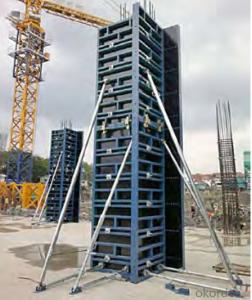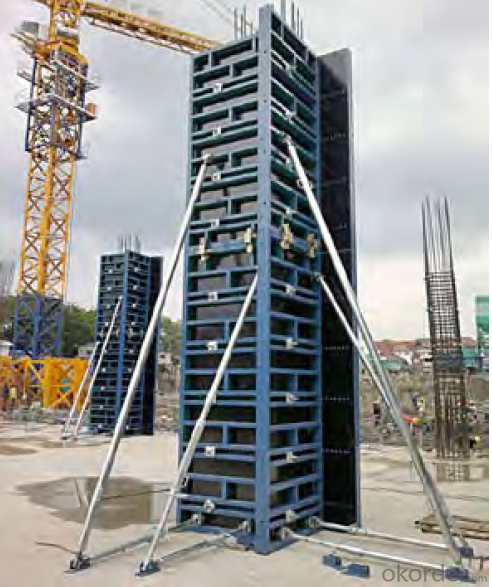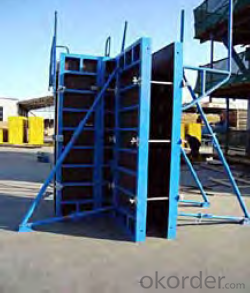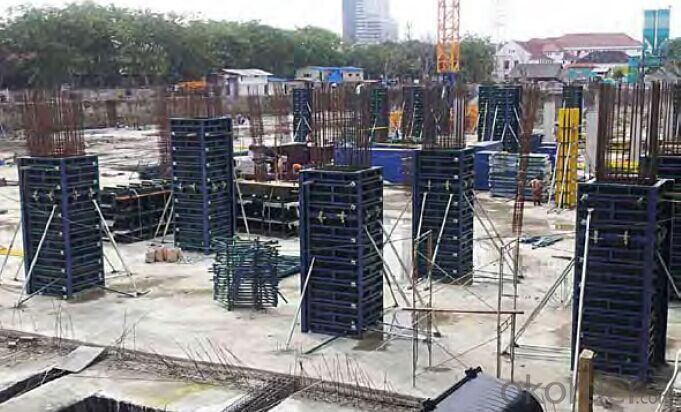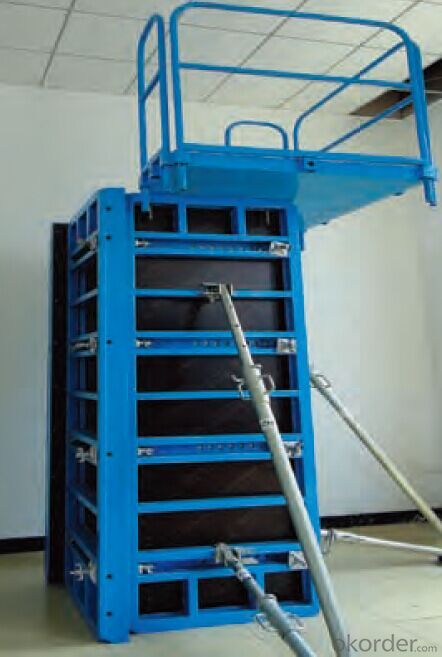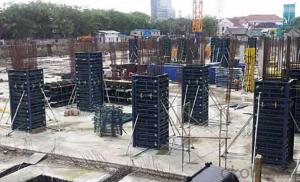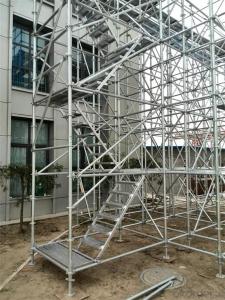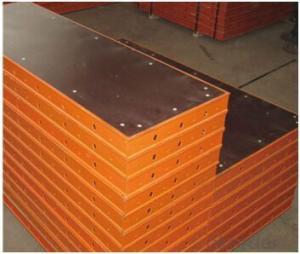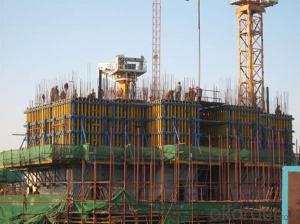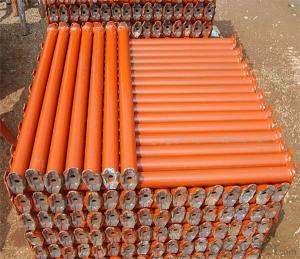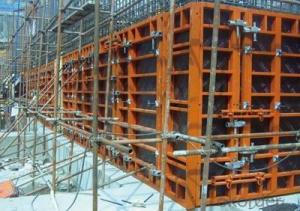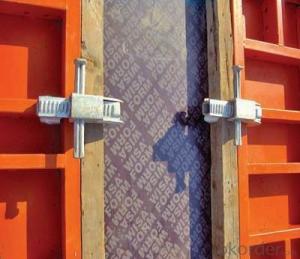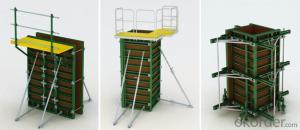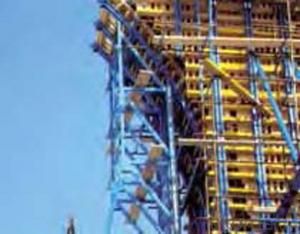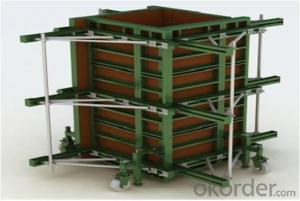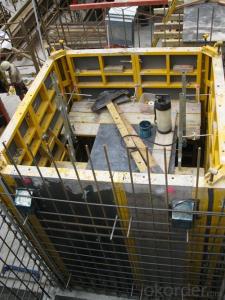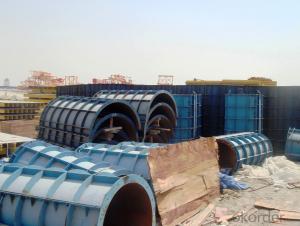Steel Frame Formwork with High Quality and Strong Competitive in Construction
- Loading Port:
- Shanghai
- Payment Terms:
- TT OR LC
- Min Order Qty:
- 1 m²
- Supply Capability:
- 100000000 m²/month
OKorder Service Pledge
OKorder Financial Service
You Might Also Like
1. Structure of Steel Frame Formwork GK120
There is a prizing part designed in the corner, which can help to position and remove formwork easily.The plywood is screwed on from the back when connecting frame and plywood, so the surface of the finished concrete is perfect.The formwork series are a complete system with a full set of accessories, and can be set up flexibly according to project demand.As the formwork,it is adapted to the plywood with thickness of 18mm.High-precision production line guarantees the perfect products.
2. Main Features of Steel Frame Formwork GK120
Light weight
High strength
Easy connection with adjustable steel clamp
Convenient and fast corner formwork
Flexible to assemble and application
3. Steel Frame Formwork GK120 Images
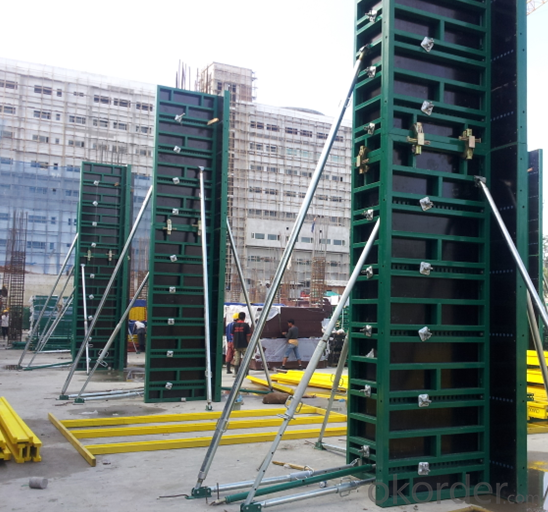
4. Steel Frame Formwork GK120 Specification
-Steel Frame Formwork GK120 is used for the concrete pouring of square or rectangle column. The system has the same structure and similar connection type with wall formwork.
-The frame is highly strengthened, and the wall formwork can bear lateral pressure 60 KN/m2 while the column formwork can bear 80 KN/m2.
-As a standardized system, it is flexible to assemble , wood batten can be filled to satisfy the need f of non-standard size.
-The adjustable steel clamp is convenient to use, and can hold tightly.
-The plywood is screwed on from the back when connecting frame and plywood, so the surface of the finished concrete is perfect.
5. FAQ of Steel Frame Formwork GK120
1) What can we do for you?
.We can ensure the quality of the vinyl banner and avoid extra expenses for customers.
.We can provide you the professional design team.
.We can provide fashionable and newest styles for you.
.We can design the artwork for you.
2) What promises can be done by us?
. If interested in Steel Frame Formwork GK120, please feel free to write us for any QUOTE.
. Please DO check goods when courier knocks your door and contact us asap if any issue.
3) What about of our after-sale service?
. Response will be carried out in 24hours after receiving any complain or request.
. Steel Frame Formwork GK120 cost can be refund after order is confirmed.
4) What about the package and shipping time?
.Packing: As Customer's Requirements
.Shipping: We have various shipping ways for our customers
.Shipping time:
Normally small orders, it just 10-15 business days to arrive your hand; When comes to the customs declaration, it may need 7 days.
- Q: Are there any limitations to the height or width of structures that can be constructed using steel frame formwork?
- Yes, there are limitations to the height and width of structures that can be constructed using steel frame formwork. The height of the structure can be limited by factors such as the stability and strength of the steel frame system, as well as the available equipment and technology to handle taller structures. Similarly, the width of the structure can be limited by the size and capacity of the steel frame formwork panels. However, these limitations can vary depending on the specific design, engineering, and construction techniques employed.
- Q: Is the bamboo plywood and wood plywood the same?
- Because of the high hardness of bamboo, with fixed drill drilling needs. Therefore, wood template is more simple and convenient. Hope to help you.
- Q: How does steel frame formwork handle the pouring and curing of concrete in extreme temperatures?
- Steel frame formwork is a popular choice in construction due to its durability and ability to handle extreme temperatures during the pouring and curing of concrete. The steel frame provides a strong and stable structure that can withstand the pressure exerted by the concrete during pouring. Additionally, the steel material has a high melting point, which makes it resistant to deformation or damage caused by extreme heat. In extreme cold temperatures, steel frame formwork offers several advantages. Firstly, the steel material has a low thermal expansion coefficient, meaning it does not contract significantly when exposed to cold temperatures. This characteristic ensures that the formwork remains stable and does not warp or crack during the concrete pouring and curing process. Furthermore, steel frame formwork can be easily insulated to prevent freezing of the concrete mix in extremely cold climates. Insulating materials such as foam boards or blankets can be attached to the steel frame, providing a barrier between the concrete and the cold environment. This insulation helps to maintain the necessary temperature for proper curing of the concrete, preventing any potential damage or deterioration. In extreme hot temperatures, steel frame formwork also proves to be advantageous. The steel material has a high thermal conductivity, meaning it can efficiently dissipate heat and prevent excessive temperature build-up. This characteristic helps to regulate the temperature of the concrete during the curing process, preventing the formation of cracks or other thermal-related issues. Additionally, steel frame formwork can be easily coated with reflective materials or painted in lighter colors to minimize heat absorption. This further aids in maintaining suitable curing temperatures, even in scorching conditions. Overall, steel frame formwork is designed to handle extreme temperatures during the pouring and curing of concrete. Its robustness, low thermal expansion coefficient, insulation capabilities, and heat dissipation properties make it a reliable choice for construction projects in a wide range of climates.
- Q: Can steel frame formwork be used for post-tensioned concrete structures?
- Indeed, post-tensioned concrete structures can make use of steel frame formwork. Post-tensioning involves the application of tension to steel cables or bars after the concrete has hardened, serving as a method to reinforce concrete structures. During construction, steel frame formwork offers a robust and long-lasting framework for pouring and shaping the concrete. It effortlessly accommodates the supplementary forces and specifications associated with post-tensioning. Consequently, the steel frame formwork collaborates with the post-tensioning elements to establish a structurally secure and fortified concrete structure.
- Q: ANSYS steel frame structure modeling, commonly used in size, density, Poisson's ratio is much better? Help。
- Steel structure with a long time carbon structural steel, the size of the size of the steel you actually use
- Q: What are the key quality control measures for steel frame formwork installation?
- The key quality control measures for steel frame formwork installation include ensuring proper alignment and leveling of the frames, using accurate measurements and dimensions, checking for any damages or defects in the steel frames, verifying the stability and strength of the formwork system, and conducting regular inspections throughout the installation process to address any issues promptly.
- Q: How does steel frame formwork contribute to the overall safety of construction sites?
- Steel frame formwork contributes to the overall safety of construction sites by providing a sturdy and stable structure for concrete pouring. Its robust construction ensures that the formwork can withstand the weight and pressure of the concrete, reducing the risk of collapse or accidents. Additionally, steel frame formwork allows for precise and accurate placement of concrete, minimizing the chances of structural defects or weaknesses. Moreover, its reusable nature reduces waste and eliminates the need for frequent dismantling and construction, reducing potential hazards associated with constant formwork assembly.
- Q: How does steel frame formwork contribute to better dimensional accuracy in concrete structures?
- Steel frame formwork contributes to better dimensional accuracy in concrete structures by providing a rigid and stable framework that ensures the desired shape and dimensions of the concrete are maintained during the pouring and curing process. The steel frame formwork acts as a guide, preventing any undesired movement or distortion, resulting in accurately aligned walls, columns, and slabs. This precision allows for seamless integration with other structural elements, enhances the overall aesthetics, and ensures the structural integrity of the concrete structure.
- Q: Can steel frame formwork be used for both cast-in-place and precast wall construction?
- Steel frame formwork is suitable for both cast-in-place and precast wall construction. This versatile and durable system can be adjusted and reused for different construction projects. In cast-in-place wall construction, the steel frame formwork is assembled on-site and used to contain the concrete during pouring and curing. It provides necessary support and shape until the concrete fully hardens. In precast wall construction, steel frame formwork is used to create molds or forms for casting concrete panels or wall sections. The steel frame formwork is designed to withstand the weight and pressure of wet concrete and facilitate the production of accurate dimensions and smooth finishes. Once the concrete cures, the steel frame formwork can be removed and reused for future precast wall production. Using steel frame formwork offers several advantages for both cast-in-place and precast wall construction. It provides high strength and stability, ensuring the integrity and quality of concrete walls. It also enables efficient and precise construction, as the formwork can be easily adjusted and aligned to meet specific design requirements. Additionally, the reusability of steel frame formwork makes it a cost-effective solution for construction projects, reducing material waste and overall expenses.
- Q: Are there any specific training requirements for using steel frame formwork?
- Yes, there are specific training requirements for using steel frame formwork. Steel frame formwork is a specialized construction technique that requires knowledge and skills to ensure its safe and effective use. Training in using steel frame formwork typically covers various aspects such as understanding the design, assembly, and dismantling procedures of the formwork system. This includes learning how to properly align and secure the steel frames, install the necessary support and bracing systems, and ensure the stability and integrity of the formwork structure. Additionally, training may also include instruction on the proper handling and storage of steel frame formwork components, as well as techniques for minimizing the risk of accidents and injuries during construction activities. It is important for individuals working with steel frame formwork to be trained in recognizing and addressing potential hazards, such as unstable ground conditions, overhead obstructions, or adverse weather conditions. They should also be educated on the use of personal protective equipment and the implementation of safety measures to prevent falls, trips, and other accidents on the construction site. Overall, proper training in using steel frame formwork is essential to ensure the safety of workers and the quality of the construction project. Employers should provide comprehensive training programs and ensure that all personnel involved in the use of steel frame formwork have received the necessary training and possess the required competencies to carry out their tasks effectively and safely.
Send your message to us
Steel Frame Formwork with High Quality and Strong Competitive in Construction
- Loading Port:
- Shanghai
- Payment Terms:
- TT OR LC
- Min Order Qty:
- 1 m²
- Supply Capability:
- 100000000 m²/month
OKorder Service Pledge
OKorder Financial Service
Similar products
Hot products
Hot Searches
